Wednesday, November 30, 2011

Seafood dish number two, of five in the pipeline. (The first was Monday’s post on New Bedford sea scallops; there’s an earlier piece on seared tuna puttanesca around here somewhere, too.) My goal is to suck you in with the suppers so you’ll stick around for the science.
If I’m using a white fish I usually try and avoid a white vegetable to keep things aesthetically interesting, but it doesn’t always work out for an impromptu Monday night dinner (i.e., I had a head of cauliflower that I wanted to use and had already defrosted the swordfish). There were specks of green due to the capers and parsley, at least, and I also garnished the dish with a few roasted Brussels sprouts. I’d probably gussy it up a bit further if I were serving this at a dinner party—a confit of red and yellow peppers around the perimeter, perhaps? Speaking of which, this is actually a perfect meal for company as it doesn’t need much active prep right before serving.
I’m sure you’re familiar with swordfish, that meaty white fish with fabulous flavor and versatility? Along with some of the white flaky fishes, swordfish is a great “starter” fish because it’s fairly mild. It’s one of my favorites, so although certain types should be avoided I’m glad it’s no longer on the endangered list. (More on the sustainability of swordfish and other environmental considerations here.)
But are you acquainted with smashed cauliflower? It has a remarkably similar taste to mashed potatoes, which are obviously quite luscious. However, the cauliflower version has arguably more flavor and texture and is certainly more nutritious and lower in calories. At the very least, it’s a creative preparation for cauliflower and a great way to mix things up. Finishing the dish with a light sauce of white wine, garlic, capers, lemon, parsley, and a bit of butter—aka, piccata, the P.K. way—brings this savory meal over the top.
Roast the cauliflower, as described here.
Cook the swordfish. Read here for more sure-fire methods on cooking seafood. Here are specific details for this dish:
- Sear. Season the fish with sea salt and freshly ground black pepper. (Omit the salt if you prefer; see yesterday’s notes about this. )In a hot skillet, sear the swordfish over high heat on one side. After 2-3 minutes, you should have a lovely brown sear on it, like the picture. If you don’t, turn up the heat and give it another minute. Turn over to achieve the same outcome.
- Roast. Place the fish into a small pan and pour ~1/4 cup of white wine over the fish and into the pan, using enough such that a small amount coats the bottom of the dish. (You can omit the wine if you prefer.) Cover the dish with tin foil and place into the oven. Roast the fish for about 12-20 minutes (time varies with thickness) at 325 degrees F.
Hey, wait: why sear and then roast? Aren’t both just forms of cooking? Good question, glad you asked. Read here for more sure-fire methods on cooking seafood. Searing fish creates a lovely brown crust, especially when using a spice rub that caramelizes, as with the scallops, but even when simply cooked over very high heat in a bit of olive oill. However, swordfish is thick and needs to be cooked through, so while you could sear over high heat then turn it down to low on the stovetop, I find roasting in the oven at a low temperature is less likely to result in overcooking. Now, some dishes can just be seared to reach a rare or medium rare temperature, like scallops or tuna. With other dishes, I’ll skip the searing and go right to the roasting, which almost never fails to produce incredibly moist, perfectly cooked fillets. (And, frankly, I don’t always feel like taking the time and creating another pan to wash. Slow roasted salmon is just fabulous on its own, for example; it certainly doesn’t require searing every time.)
Smash the cauliflower, as described here.
Prepare the sauce. Once the fish comes out of the oven, let it rest for 5 minutes or so— which is all the time you’ll need to make the piccata. Reheat on high the same pan you used to sear the fish, along with a tablespoon of olive oil. Add 1-2 cloves of crushed garlic, stir until fragrant, then add ~1/2 cup white wine to deglaze the pan. (You can use vegetable stock if you prefer.) It will quickly come to a boil. Next, stir into the sauce juice from 1/2 of a lemon, 1-2 tbsp capers, and 1-2 tbsp chopped parsley. Turn the heat to low at this point so all the liquid doesn’t evaporate, else you’ll be left with burnt bits of garlic rather than a sauce. Whisk in 1 tablespoon of butter and/or a bit of cream to add body to the sauce. Taste, and adjust the seasonings (salt, pepper) as necessary. If you used too much acid (white wine, lemon), you might add a touch of honey or agave to readjust. The sauce should not be sweet, but if you find yourself puckering go ahead and grab a sweetener, it’s fine. Likewise, if the sauce seems too thin you could add a bit more butter. It’s a creative process, right? It could take some futzing your first time, so give it a little taste every time you make an adjustment. Just make sure you save some for the fish…
Add the fish to the sauce (or not). Once you are satisfied with your sauce, and assuming there is still some left, place the fish into the pan to coat one side, then turn it over to coat the other side. Feel free to omit this step if you like and proceed to the final step below. (I just happen to like things saucy.)
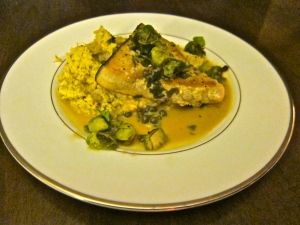
Plate the dish. Mound a portion of smashed roasted cauliflower onto the plate, then artfully place the fish atop the vegetable. Spoon the tangy sauce over the fish, allowing it to pool on the bed of the plate. Garnish as desired (shown here with roasted caramelized Brussels sprouts I had on hand).
Wait for kisses from your partner.*
—
* No partner? No problem. Look into the closest mirror, say “I’m awesome,” then dig in.

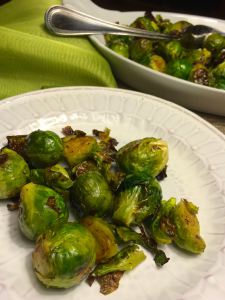
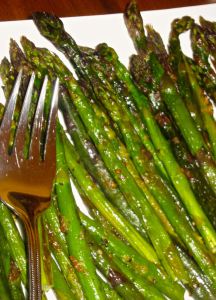
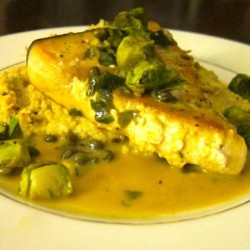
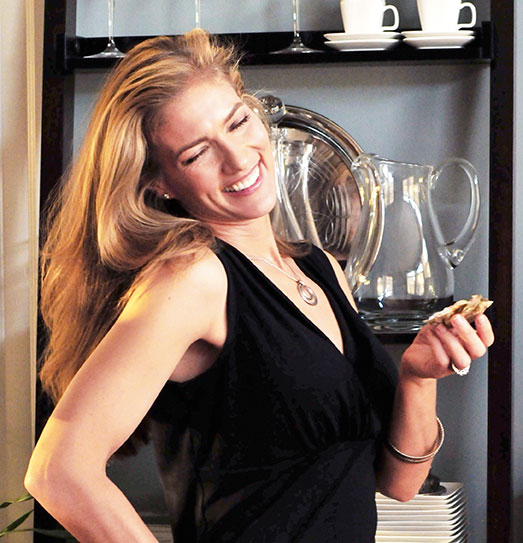
swordfish and n-3 FA 😀 … beautiful dish, must be yummmmy !!!
Thanks, Bonnie! Try it out! It was very tasty indeed and very easy to make :)!
PKN